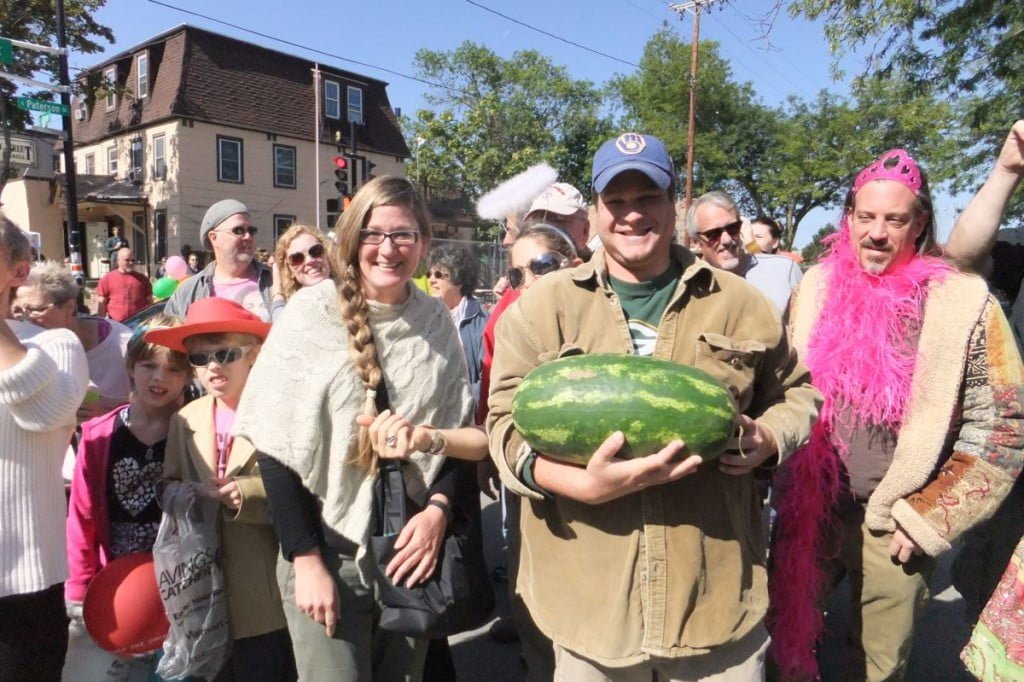Monthly Archives: September 2014
Farm and raspberry news
- On: September 24, 2014
 0
0
We have enjoyed this week so, so much. An entire week of warm, dry weather at this time of year is a gift. Mud and rain complicate every task.
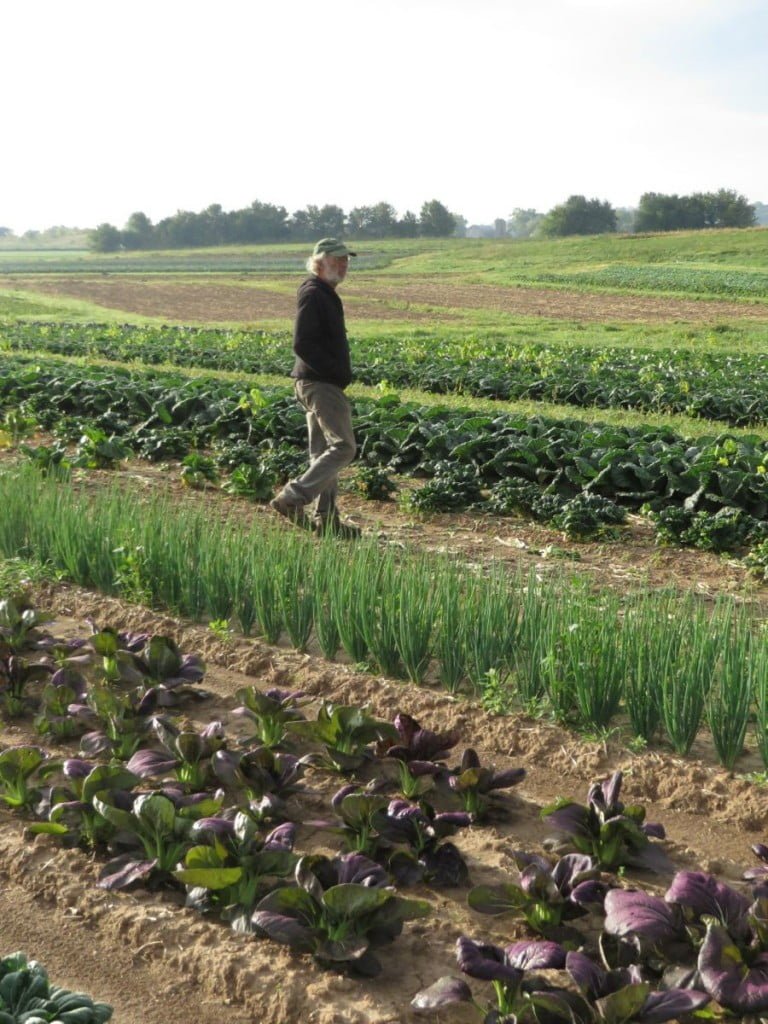
Steve walks the farm in the morning to make his harvest decisions. I love this corner of our farm. Unlike most of our flat fields, this area is a basin. Steve contours the fields, so they are all at different angles.
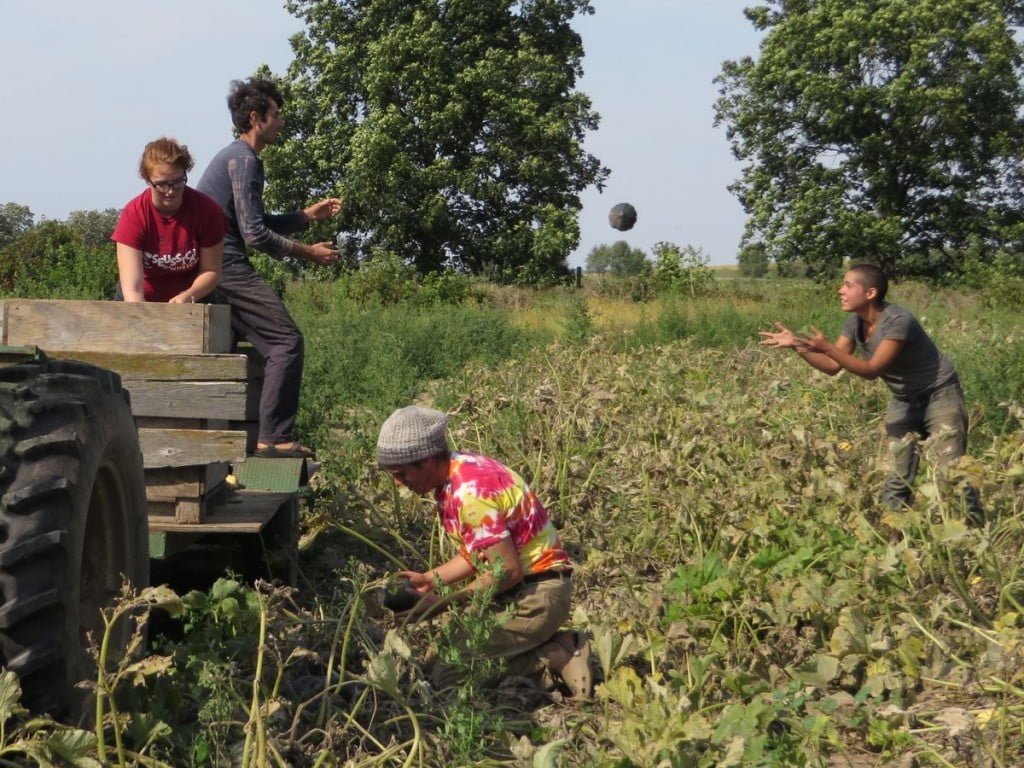
We are making progress with our winter squash harvests. All the Sweet Dumpling, delicata, acorn and Sugar Dumplings are tucked away. We’ve begun the butternut harvest, but there are many more to pick. It looks like a very good squash crop this year. From right, Boi tosses acorn squash, Jory clips the squash, Jon catches, and Caitlyn packs the acorns into wooden bins.
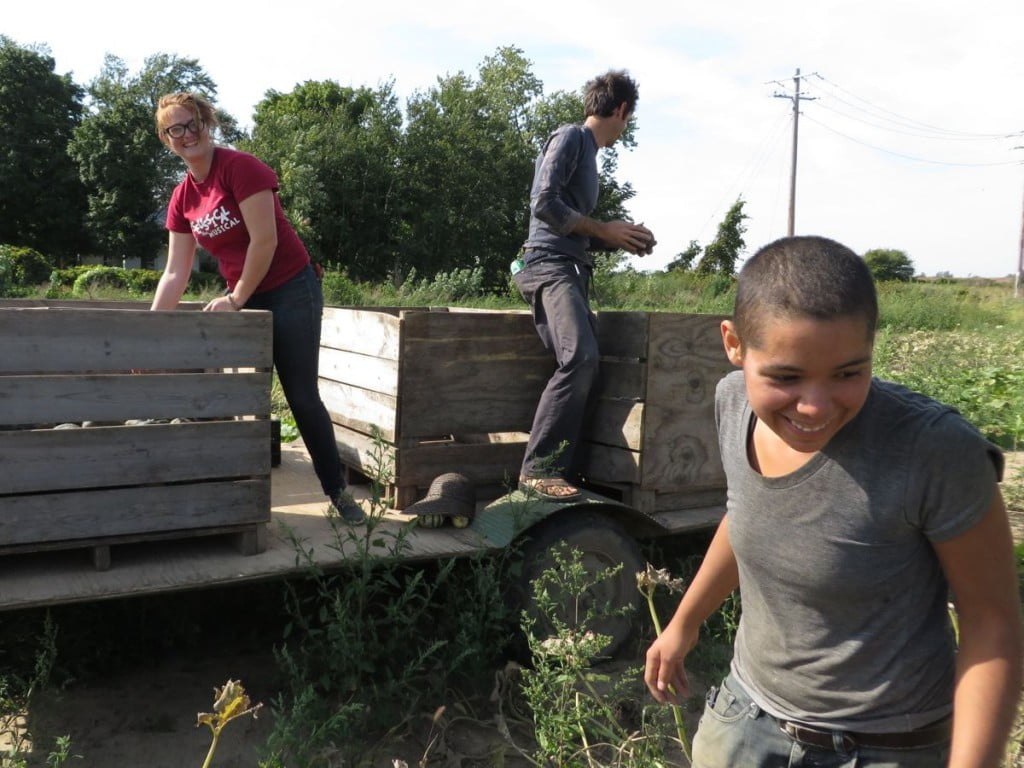
Our farm work is so enjoyable on warm days.
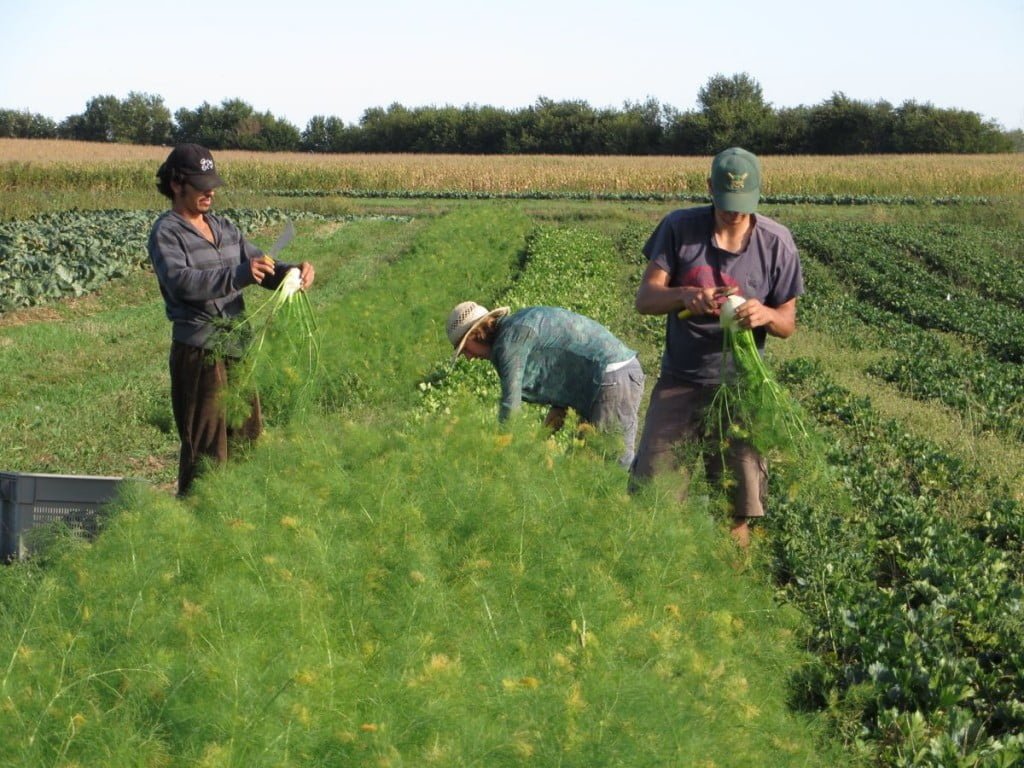
From left, Mario, Kerry and Tristan harvest fennel for your CSA boxes this week.
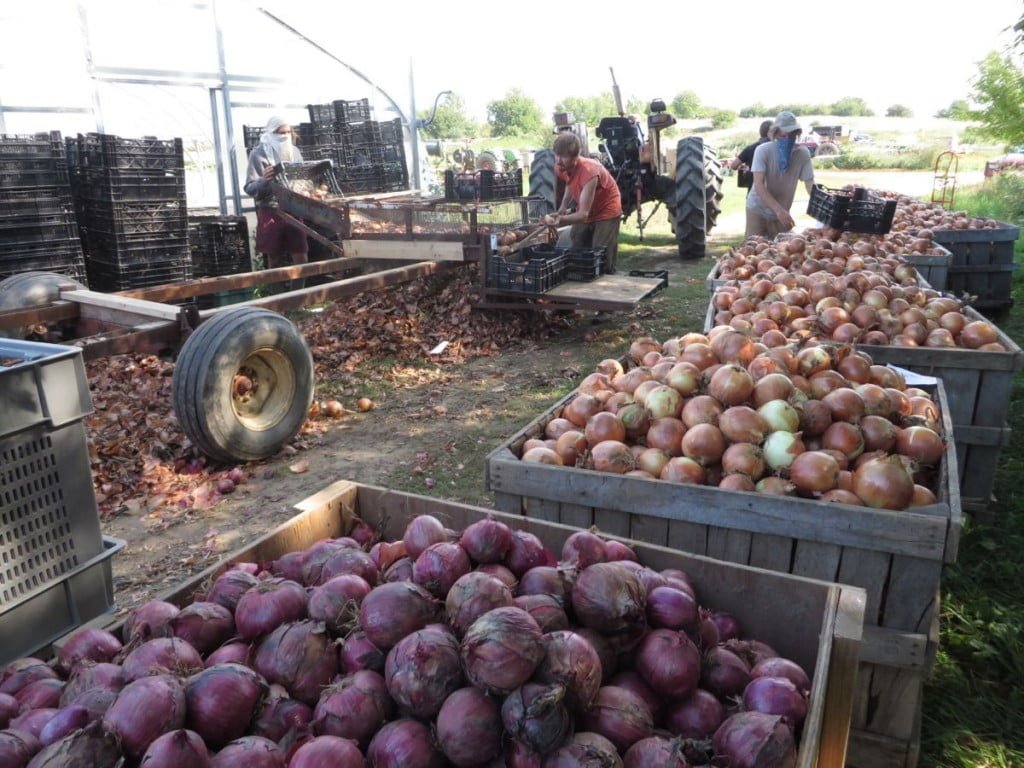
From left, Clint, Billy and Michael clean onions. We dry our onions in the greenhouse, then run them though a topper to remove leaves and loose skins, and knock off most of the dirt. It is a dusty job, so it’s great to take care of this step outside. Now the onions are stashed in our dry storage cooler.
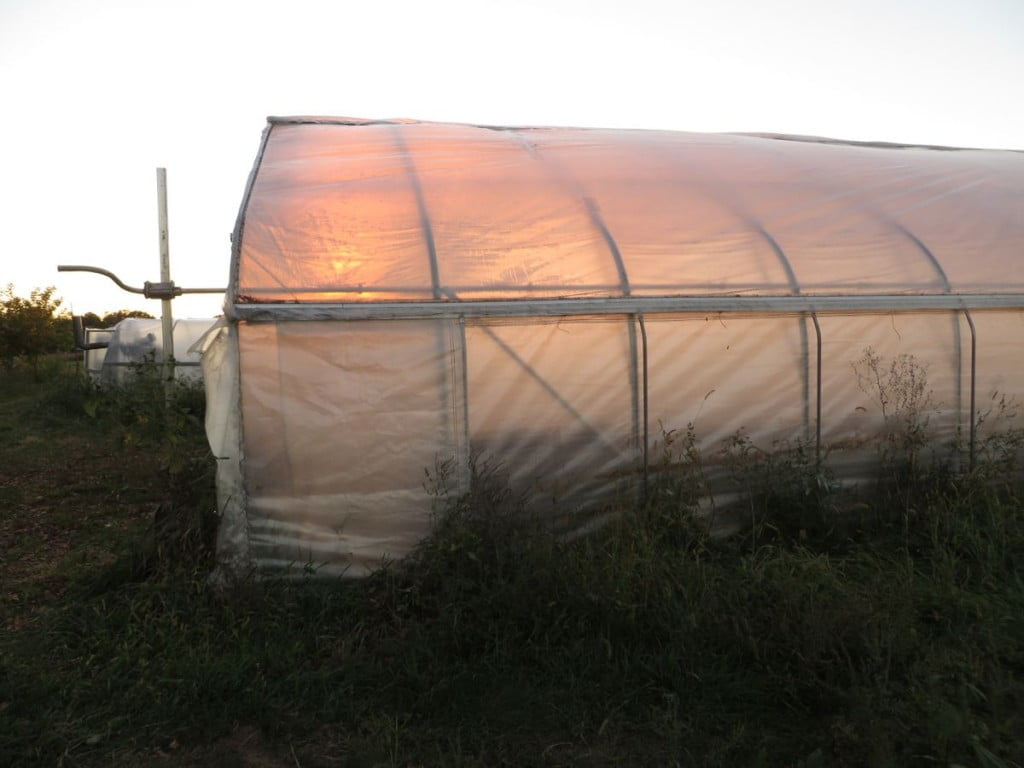
Sunset through the greenhouse.
Raspberry update
It is time to acknowledge that we will not have raspberries for the CSA boxes, nor will we host raspberry u-picks. Spotted wing drosophila (SWD) have wreaked havoc again this year. This fruit fly pest arrived in the USA in 2008, and in Wisconsin in 2012. We invested in growing a raspberry crop this year, but our techniques to control SWD failed. We are collaborating with UW entomologists again this year (and will next year too). So far, their studies have focussed on the fruit fly’s biology and behavior, as there are big gaps in basic knowledge about the pest. This past winter answered an essential question of whether SWD can survive our coldest winters. The answer is “yes.” Remember last winter’s Polar Vortex? The fruit fly survived without trouble.
At this point, our primary concern is learning enough about SWD to avoid risk to our strawberry crop too; the fruit fly showed up at the end of the strawberry season this year. We will grow raspberries again next year, and will try to control the fruit flies with cultural methods. Picking every berry is essential to controlling SWD. This can work quite well on a home garden scale. We plan to reduce the size of our field, narrow the rows, prune out early flowers and try our best to pick every berry. This is a tough situation for all raspberry growers and we are still learning how to manage this new pest.
We are disappointed that we couldn’t offer raspberry u-picks this fall. We will probably offer some berries to pick during the pumpkin and gleaning party. We’ll keep you posted. Beth
Earlier posting of the weekly veggie list?
A few members have asked us to post our veggie list earlier. I am now posting the week’s list in our website sidebar by about 7 pm Wednesday night. This is a few hours earlier than I have our newsletter ready. The sidebar “Box Contents” is visible on the right side of both our homepage and our farm newsletter page. I hope this helps.
Veggie list and veggie notes (9/25/14, week #19, green EOW)
Green cabbage
Cauliflower AND/OR broccoli
Fennel, 1 bulb
Green beans, 1/2 lb
Bell peppers, about 2
Red onion, 1
Yellow onion, 1
Slicing tomatoes, just a few
Poblano chiles, 3
Lettuce, 1 medium head
Garlic
Next week’s box will probably contain winter squash, potatoes, leeks, cilantro, peppers, carrots and more.
Fennel – We have trimmed away most of the fronds so the fennel will fit in the box. The plants stand three feet high out in the field. We’ve left the tender central fronds so you can chop and add them to cooked dishes for extra anise flavor.
Fennel is a ‘swing vegetable’; it can be used raw or cooked. Clean well and slice as thinly as possible for use in raw salads. It is good simply prepared with olive oil, lime or lemon juice, salt and shaved parmesan cheese. Cooking softens and sweetens fennel, and mellows its anise flavor. Both the bulb and leaves are edible. We’ve send the fennel in combination with the last few tomatoes because they are so good cooked together. I asked Pat of Local Thyme to come up with an interesting use this week.
Slicing tomatoes – We will send just a few tomatoes this week. The tomato season is nearly over. These late season tomatoes are a bit soft and will not store for very long. Eat them up. Personally, I prefer to cook late-season tomatoes, rather than prepare them raw.
Poblano chiles – The flavor of the poblanos is quite good this year. As I wrote a few weeks ago, these chiles are unusually mild this year, with occasional hot ones mixed in. Remove the seeds and midveins to reduce the chance of heat. Taste a sliver. Use your best judgement.
Lettuce – This is the last lettuce of the year!
Youthful energy
- On: September 17, 2014
 0
0
Every day, our work crew carries us forward with their youthful energy. Maggie and Clint organized a Tipi contingent for the Willy Street parade this past weekend. They asked us to walk with them. We stalled, viewing it as another chore. We are quite busy this time of year. They convinced us with their enthusiasm and creativity. We are so glad they did! It was a blast.
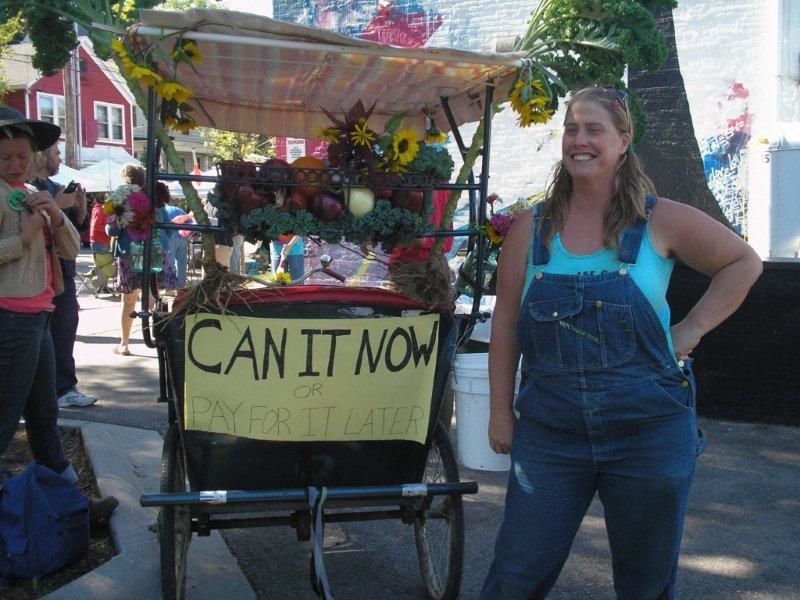
Ringleader Maggie with her decorated rickshaw. Maggie is an expert at canning, freezing, drying, pickling – all forms of food preservation.
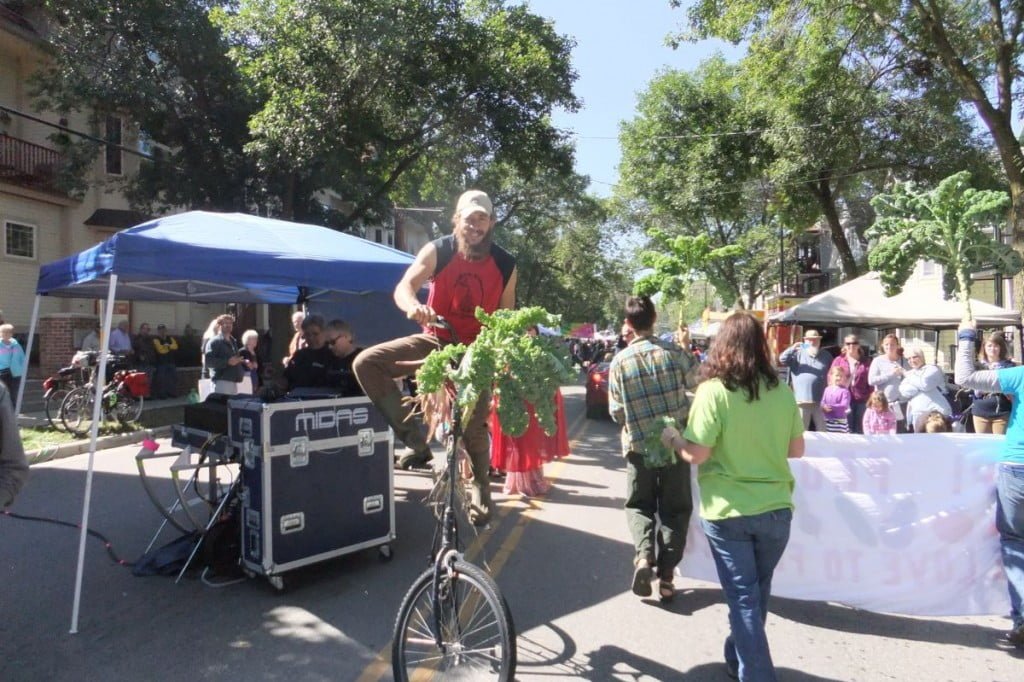
Ringleader Clint dug up beautiful kale plants for us to carry. With their denuded stems, they look just like palm trees.

The kale was a hit with Billy’s son.
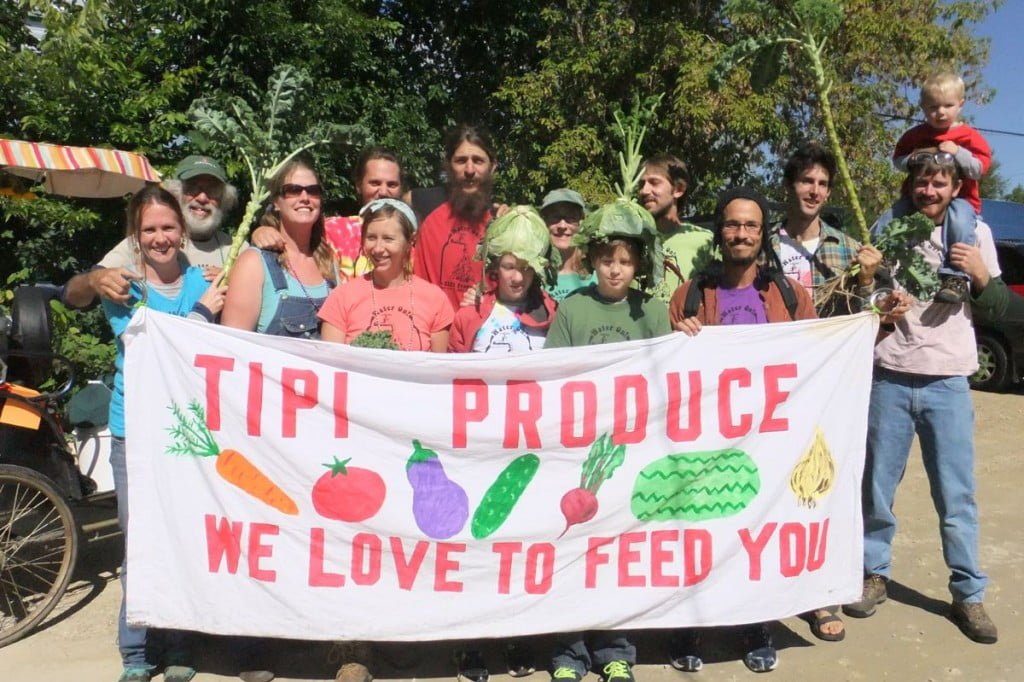
Maggie and her mom made us a banner. We all wore “Water On!” t-shirts that Maggie silk-screened for us a few months ago. From left, Karen, Steve, Maggie, Jory, Bonnie, Clint, the boys with me behind them, Andy, Mario, Jon, Billy with his little boy.
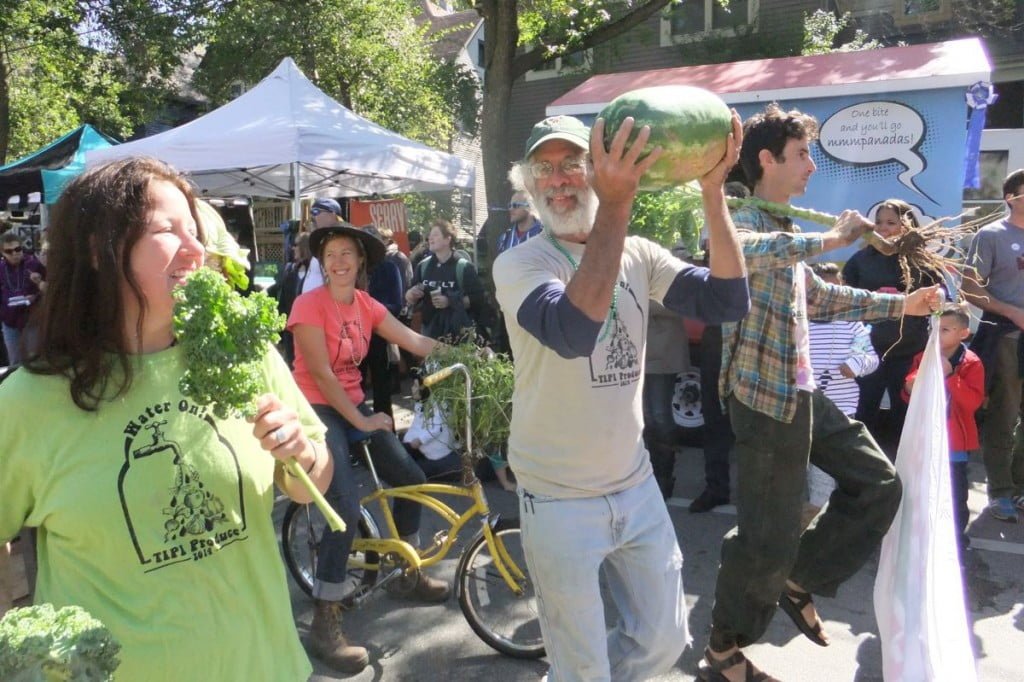
Steve danced his way down the street with a watermelon. We handed out peppers, cherry tomatoes and a few watermelons. We could not hand out candy! Blue (left) joined us for a block during her lunch break. Bonnie rode her festooned bike and handed out produce. Jon marched and twirled his kale stalk as our ‘kale guard’ – it’s like color guard but with a kale stalk instead of a baton.

Our son and his buddy wore cabbage caps. Good thing they are not shy kids.
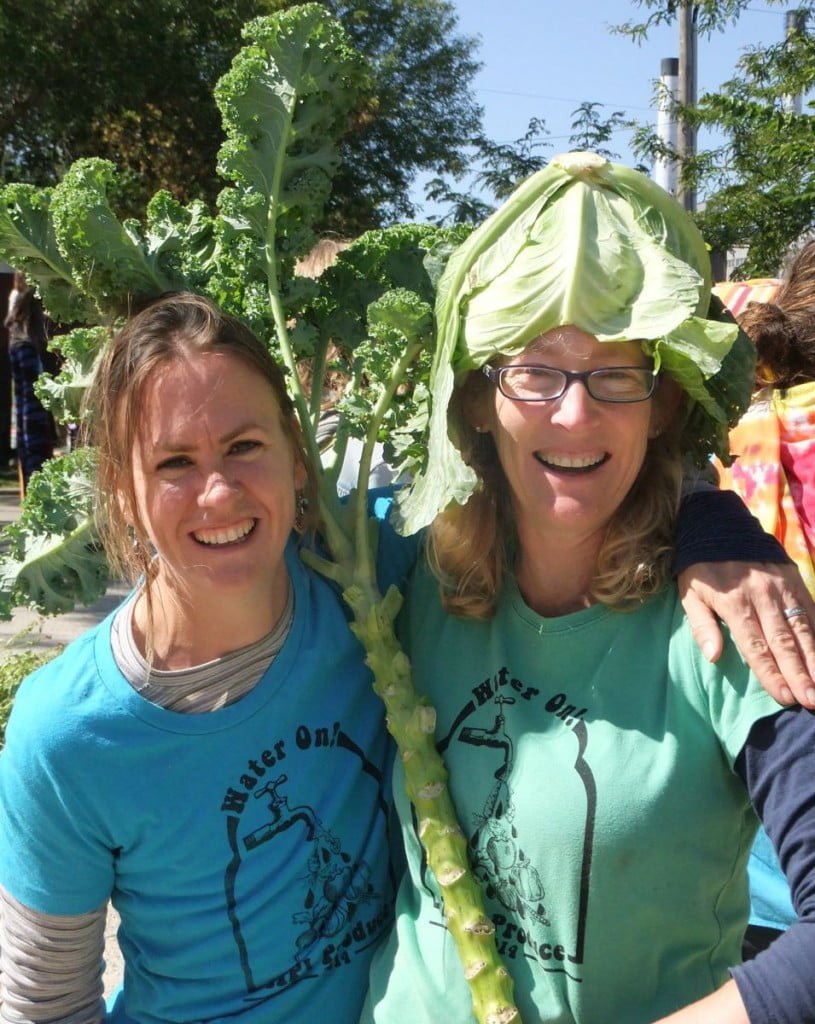
See? Everyone looks good in a cabbage cap. Karen and Beth (that’s me.)
Farm news.
Of course, it’s back to work for us now. There were a few light frosts this past week. We checked the sweet potatoes first – they are our most frost-sensitive crop. Sure enough, the tops of the foliage were singed. That’s a wake-up call for us even though the damage was slight. In summer, time for work seems endless. The weeks go on forever. By this time of year, we can feel the limits of the season yet there is still so much to do. We were glad to wrap up a few summer crops like zucchini and onions, but now we must move on to the next urgent harvests. We have a beautiful winter squash crop, and will hurry to get that and the sweet potatoes tucked away in the next two weeks.
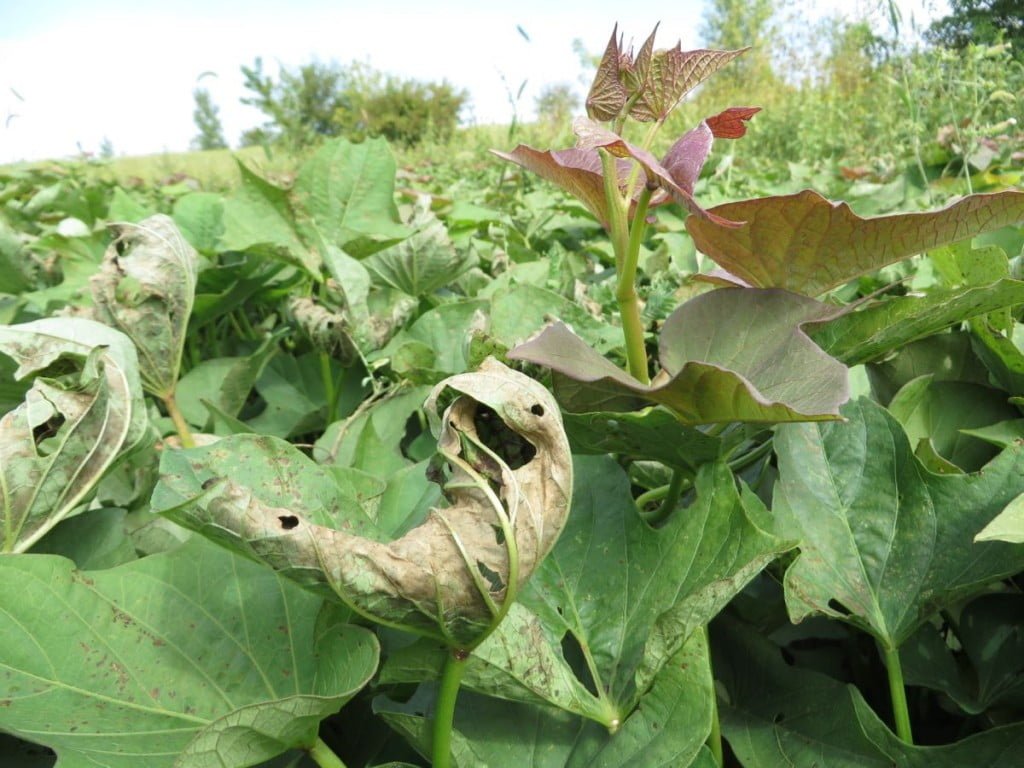
The curled sweet potato leaves were damaged by frost. The damage is not severe, but it is enough to hurry us along.
Veggie list and veggie notes (9/18/14, week #18, purple EOW)
Delicata winter squash, 2
Snap beans, green &/OR yellow, almost 1 lb
Cauliflower AND/OR broccoli, 1 or 2 heads
Slicing tomatoes, 2.4 lb
Broccoli raab, 1 bunch
Green bell pepper, 1
Red bell pepper, 1
Scallions, 1 bunch
Yellow onions, 2
Purple OR green kohlrabi
Jalapeño (hot), 1
Next week’s box will probably contain snap beans, fall brassicas (cabbage/cauliflower/broccoli), tomatoes, peppers, carrots, winter squash, poblano chiles and more.
Delicata winter squash – These are flavorful, thin-walled winter squash. You can even eat the skin. Like the Sweet Dumpling we sent last week, delicata will not store for long, so eat them soon. There may be flaws that need trimming before or after cooking.
Storage: Store all winter squash at room temperature.
Preparation: These squash have a central cavity that can be stuffed if you wish. Cut squash in half, scoop out and discard the seeds. To cook, I place the cut squash face-down on a cookie sheet, then put some water in the pan, and roast at 400 oF until easily pierced with a fork. The water in the pan is optional. The flavor is best if you allow the pan to dry during the cooking, so the squash has a chance to caramelize.
Purple OR green kohlrabi – Crunchy and sweet, kohlrabi is a great addition to salads. Some of the purple kohlrabi are scarred from strong storms last month. The green kohlrabi from the adjacent row show no damage. They are simply sturdier. We see this with a lot of red or purple vegetables. They are pretty but often less vigorous than their green counterparts.
Storage: Kohlrabi bulbs will store for a month in the refrigerator.
Uses: Kohlrabi are good peeled and eaten out of hand, or added to sandwiches. It is good mixed into salads, or prepared as a salad on it’s own. You can grate it, slice it, or cut it into matchsticks. It’s also good cooked. If you have it, the Asparagus to Zucchini cookbook has a long list of kohlrabi suggestions.
Broccoli raab (large bunch of tender greens) – This cool-season vegetable is also known as rapine, and is similar to “broccolini.” Has a robust flavor similar to mustard greens. Broccoli raab is harvested with young flowering stalks. Chop and include these tender stalks when cooking. Similar cooking time to mustard or turnip greens. After years of trying, this is our first successful crop of this nutrient-rich green.
Jalapeño (small, dark green or red chile) – These are hot.
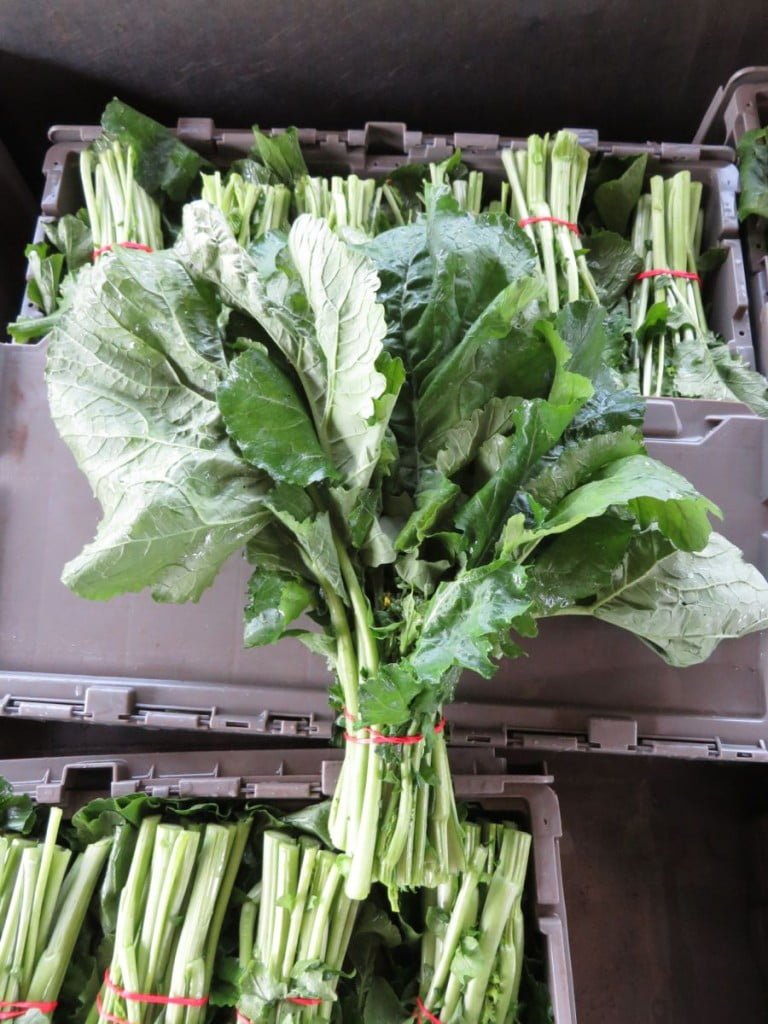
A generous bunch of broccoli raab.
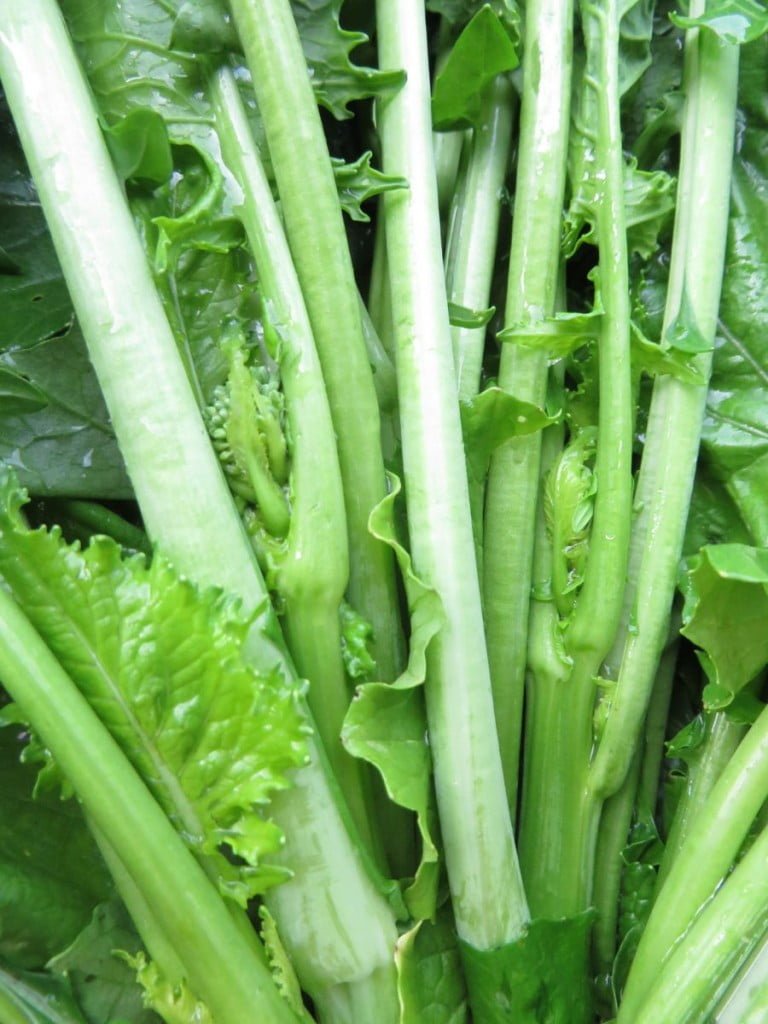
Include the tender flower stalks when you cook the broccoli raab.
Sept 11 2014
- On: September 10, 2014
 0
0
Veggie list and veggie notes (9/11/14, week #17, green EOW)
The switch to fall crops has begun, with winter squash, cauliflower and broccoli harvested this week.
Red potatoes, 3.5 lb
Cauliflower AND/OR broccoli
Sweet Dumpling squash, 2
Slicing tomatoes, 1.5 lb
Plum tomatoes, 2 lb
Mixed sweet peppers
Lettuce, 1 small head
Yellow onions
Garlic
Some sites will get an heirloom tomato
Next week’s box will probably contain red cabbage, broccoli or cauliflower, tomatoes, peppers and more.
Red potatoes – My favorite potato farmer Chris Malek retired from farming this year. Chris and I shared a lab during graduate school at UW/Madison in the 1990’s. He is very conscientious and I always trusted him to do a great job with the potatoes. On Chris’ recommendation, we’ve bought this batch of organic potatoes from his cousin Chad Malek. We only buy a few items for our CSA (potatoes, mushrooms, some garlic) and want the quality to be consistent and high.
Sweet Dumpling winter squash (round, speckled green and white or yellow) – This is one of our most flavorful winter squashes and a personal favorite. Sweet Dumpling are one of the first winter squash types ready to eat in fall. These will not store for long so eat them soon.
Storage: Store all winter squash at room temperature.
Preparation: These squash have a central cavity that can be stuffed if you wish. Cut squash in half, scoop out and discard the seeds. To cook, I place the cut squash face-down on a cookie sheet, then put some water in the pan, and roast at 400 oF until easily pierced with a fork. The water in the pan is optional. The flavor is best if you allow the pan to dry during the cooking, so the squash has a chance to caramelize.
Mixed sweet peppers – We are sending mostly sweet Orano peppers this week. These orange peppers are the best flavored peppers we have right now. Excellent raw or cooked.
The challenges of a bumper crop
- On: September 03, 2014
 0
0
This is absolute peak season. We have five coolers running right now, and each is full the night before deliveries. The trucks are stuffed. Our hard-working crew has kicked into high gear. These peaks are inevitable and desirable. How do we handle these moments? Here are our ‘pressure valves’, our strategies to make good use of abundant produce:
- First, we stuff the CSA boxes. We want to share as much as we can with you members. This week’s box is full and heavy again. Fortunately, it’s summer produce that everyone loves.
- Steve encourages our store customers to put abundant items on sale. For example, Willy Street Coop has our watermelons on sale this week.
- We sell extra produce to you folks. This is the time of year when we can spare some tomatoes and peppers from the CSA boxes. Freeze or can them and enjoy in winter.
- We donate less-than-perfect produce to Second Harvest Foodbank, which distributes it to food pantries, soup kitchens and families in need.
- We are going to can tomato juice again this year! That will consume 1500 lb ripe tomatoes, and means there will be tomato juice in your CSA boxes next year. This is a great way to capture perishable tomatoes at peak flavor.
- We find ourselves with an abundance of round watermelons over 25 lb. Not even the stores will take melons this big. We are donating 1000 lb of these melons to FairShare’s Bike the Barns fundraiser so they can feed them to thirsty bicyclists.
.
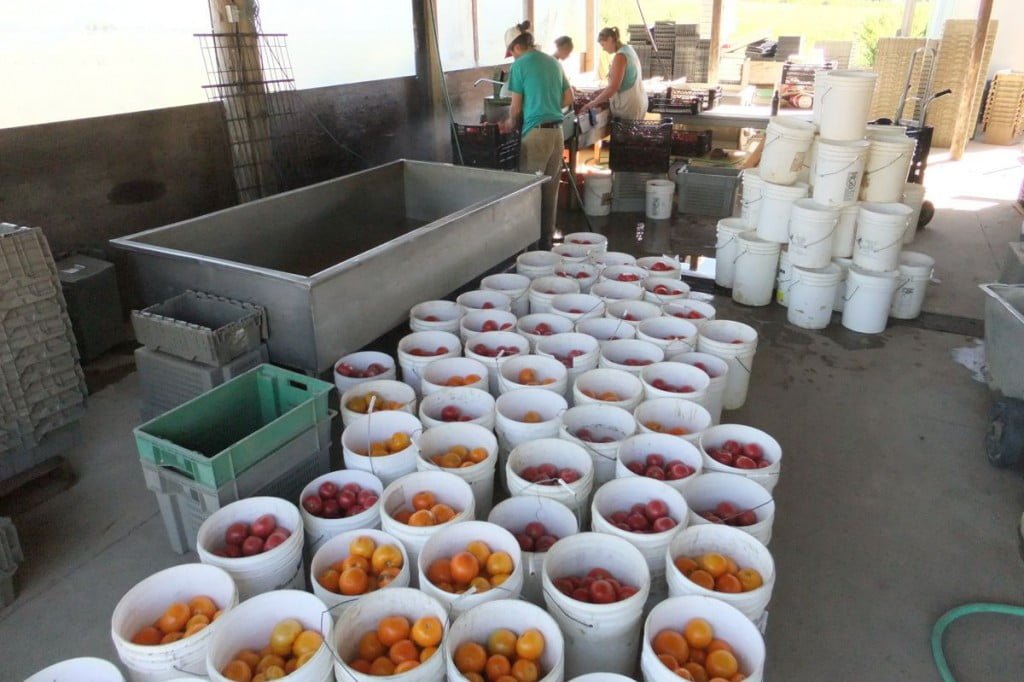
A sea of tomatoes for the CSA boxes. At back, Jory, Boi and Maggie wash tomatoes.
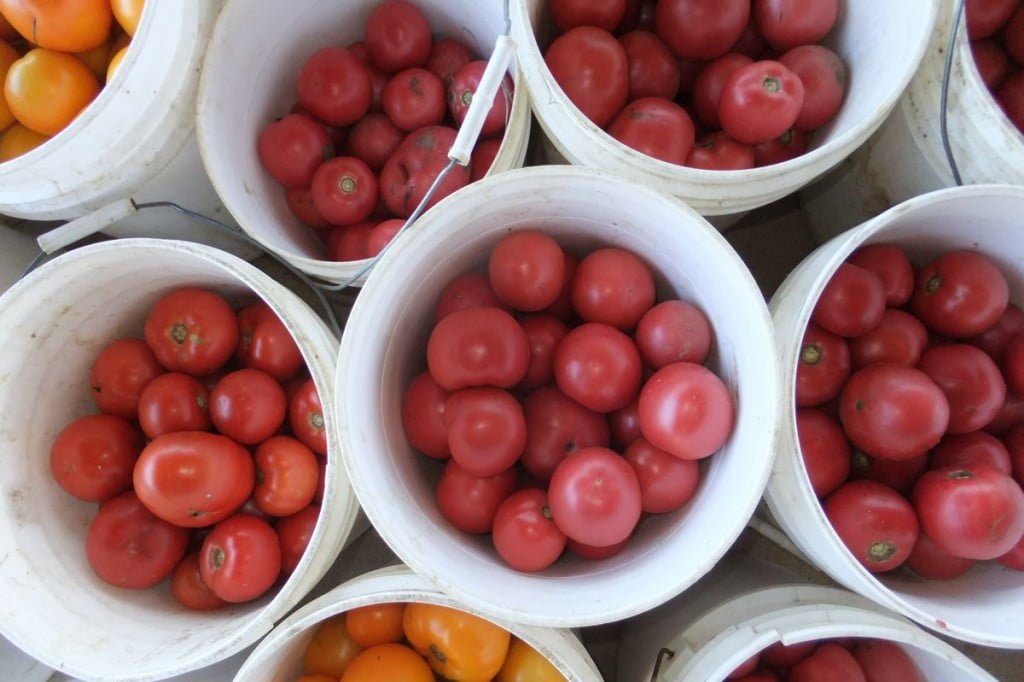
Yellow, red, and pink slicing tomatoes, ready to be washed.
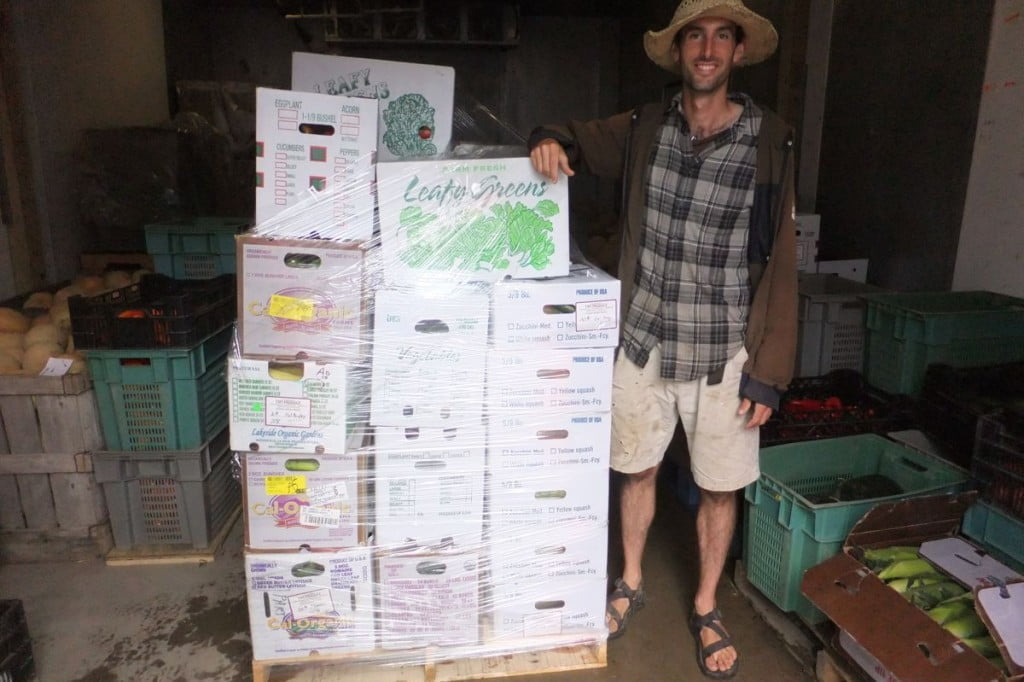
Our packshed manager Jon with a donation ready for Second Harvest. We donate #2 grade produce each week.
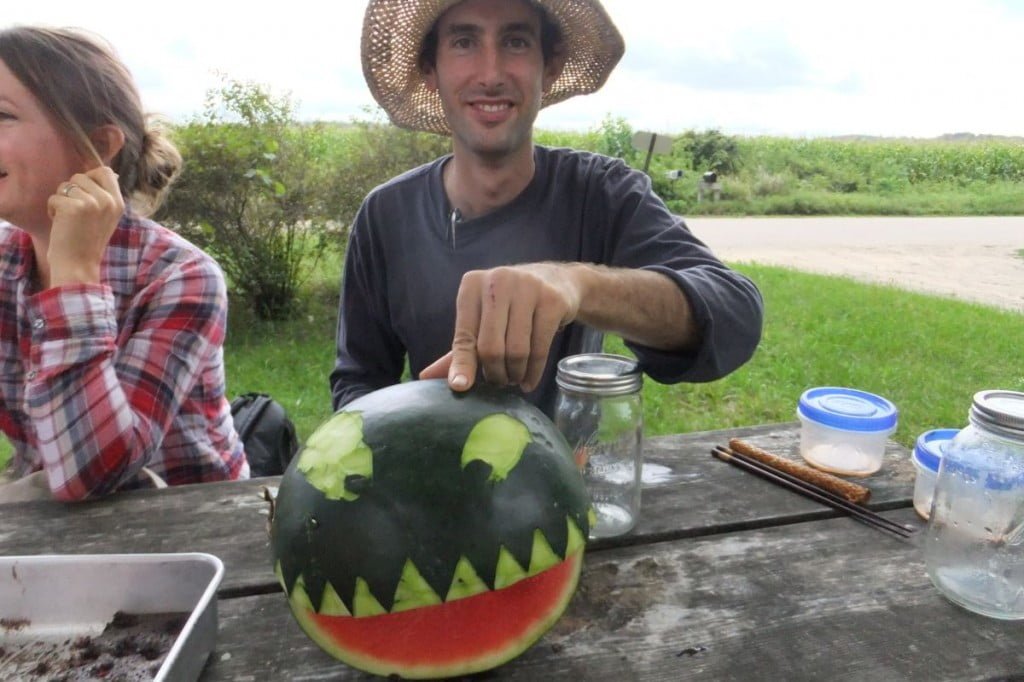
Finally, we try to be creative with our excess produce. Jon and friend, with Karen at left.
Veggie list and veggie notes (9/4/14, week #16, purple EOW)
Red watermelon
Sweet corn, 4 or 5 ears
Cauliflower OR edamame soybeans OR cherry tomatoes
Red frying peppers, about 2
Orano peppers, about 3
Poblano chiles, 3
Slicing tomatoes, 3.5 lb
Leeks, about 1.5 lb
Garlic
Basil, 1 sprig
Zucchini, 1
An heirloom tomato OR cherry tomatoes
Next week’s box is likely to contain red cabbage, red potatoes, garlic, cauliflower or broccoli, lettuce, scallions, peppers, tomatoes and more.
Watermelon – This is probably the last melon. We have simply run out of melons that will fit in the CSA boxes, plus the fall produce is ripening. You can still buy our large melons at Willy Street Coop, Outpost Natural Foods, Basics Coop and Paoli Natural Foods. We will supply them with melons for a few more weeks.
Sweet corn – This sweet corn variety is not particularly sweet. It’s a new variety for us. However, the ears are big and the flavor is terrific. This corn is excellent cut from the cob and added to dishes. We tried three new sweet corn varieties this year because our standard variety was not available this year. This one was very productive but I think we’ll look for sweeter varieties next year.
Edamame soybeans (bundle of stems with pods) – It was not an abundant year for edamame. Only one spring planting survived, sparsely. We’ll try again next year.
These edible soybeans are a treat. Pull the pods from the stem and wash well. It helps to submerge the pods and rub them together. Boil in water until the pods have split and the beans are quite tender. Season with salt and pop the beans out of the pods into your mouth. This Japanese specialty is becoming more and more popular in the USA.
Storage: Remove the pods from the stems promptly and refrigerate.
Red frying peppers and Orano (orange) peppers – These peppers are all sweet. Some of these peppers may be part green and part red (or part orange). You can distinguish them from the spicier poblanos because the poblanos are solid green.
Poblano chiles (dark green, shiny, triangular) – These chiles have low-to-medium heat and great flavor. Most I’ve cooked so far this year are milder than usual, but a few were corkers.
Leeks (look like big scallions) – These alliums have a milder flavor than onions. Nonetheless, they can be used in recipes that call for onions. To wash, split the leek lengthwise, from the green tops about halfway to the base, leaving the base intact. Rinse well under running water, separating the layers to flush. If necessary, split the leek further if soil has penetrated more than halfway down the leek. Shake dry. Leeks are generally eaten cooked. They can be sauteed, steamed or roasted. Intact leeks will store 2 to 3 weeks if covered loosely and refrigerated. The outer leaves will yellow. Just peel them off and discard. The inner leek layers will be fine.
Garlic – This batch is from John Hendrickson of Stone Circle Farm again.
Basil – We’re sending another small sprig of Thai basil. It is tolerant to the downy mildew disease spreading across Wisconsin, so we still have a small amount to share.
Heirloom tomatoes (large tomato that’s not in the paper bag with the other tomatoes) – Heirloom tomatoes are full-flavored but delicate. If you receive one this week, please handle it gently. These fragile beauties bruise easily. You might have to ripen your heirloom tomato at room temperature for a day or two. Don’t let it get overripe.
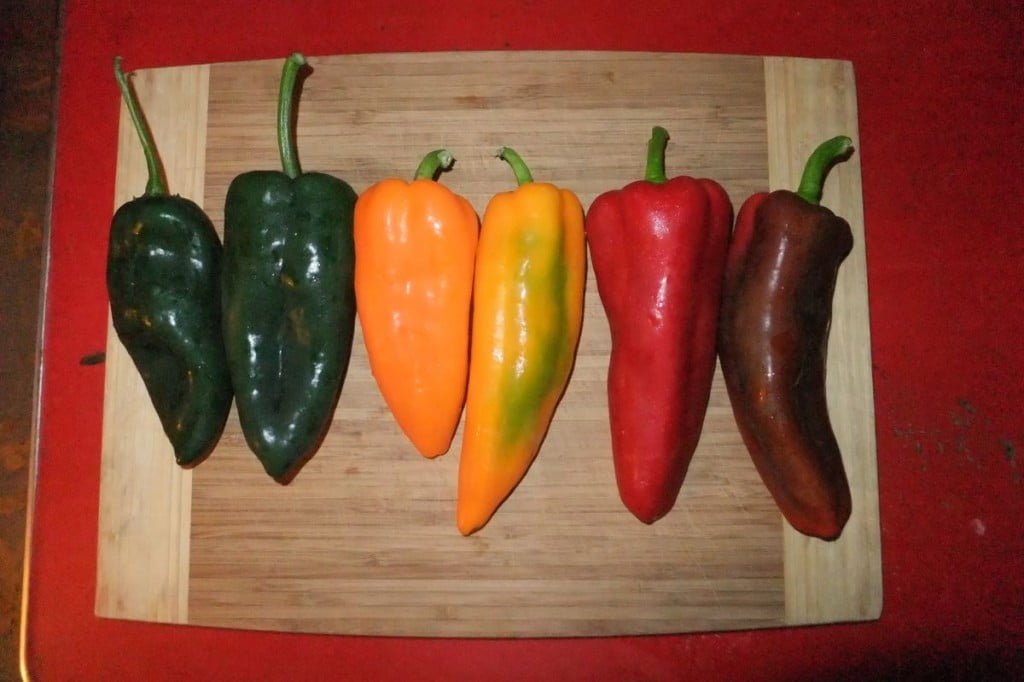
Poblanos (left, low-to-medium heat), Oranos (center, sweet), and red frying peppers (right, sweet). The Oranos and frying peppers might have a bit of green. The poblanos will be all green so you can recognize them.


